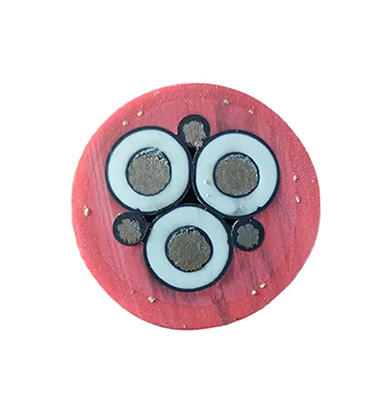A High Voltage Reel Cable is a heavy-duty power transmission cable designed for use with reeling and winding systems in demanding industrial environments. It is engineered to deliver stable high-voltage electricity while withstanding constant motion, torsion, and mechanical stress.
Industries that rely on high voltage reel cables include:
Ports and Shipyards (cranes, container handling)
Mining and Tunneling (drilling, excavation equipment)
Steel and Metallurgy Plants (rolling mills, hoists)
Energy and Utility Infrastructure (mobile substations, offshore platforms)
By combining durability, flexibility, and compliance with energy-saving standards, high voltage reel cables are essential for efficiency and safety in modern industrial operations.
Energy efficiency is a critical factor in high-voltage applications. Manufacturers design reel cables according to international standards to minimize energy losses, optimize transmission, and support sustainable practices.
IEC 60245 / IEC 60502: Ensures low electrical resistance and efficient power delivery.
RoHS and REACH Compliance: Eco-friendly materials with reduced hazardous substances.
Optimized Conductor Design: Fine-stranded copper reduces electrical resistance and heat generation.
Thermal Stability: Jackets and insulation rated for -40°C to +90°C operation, minimizing energy waste.
Reduced Line Losses: High conductivity ensures less energy wasted during transmission.
| Standard/Feature | Benefit |
|---|---|
| IEC 60245 / IEC 60502 | International compliance, safety & reliability |
| RoHS / REACH | Environmentally safe materials |
| Fine-Stranded Conductors | Lower resistance, higher efficiency |
| Heat-Resistant Jacket | Stable performance in high-load conditions |
A reel cable is designed with multiple protective layers to ensure durability under constant winding and unwinding.
Conductor – Flexible fine-stranded copper for high conductivity.
Insulation Layer – Made of EPR (Ethylene Propylene Rubber) or XLPE (Cross-linked Polyethylene).
Inner Sheath – Provides an additional layer of protection.
Reinforcement – Textile braids or aramid fibers for tensile strength.
Outer Jacket – Heavy-duty PUR or rubber for abrasion, oil, and weather resistance.
| Component | Material Options | Function |
|---|---|---|
| Conductor | Fine-stranded copper | High conductivity & flexibility |
| Insulation | EPR / XLPE | High voltage insulation |
| Inner Sheath | Rubber / TPE | Extra protection |
| Reinforcement | Aramid fibers, braids | Tensile and torsional strength |
| Outer Jacket | PUR / Rubber (CPE, PCP) | Weather, oil, and abrasion resistance |

Ensure proper reel alignment to prevent twisting or tangling.
Maintain the minimum bending radius (typically 10–12 × cable diameter).
Avoid sharp edges or obstacles along the cable path.
Do not exceed the cable’s rated voltage and current capacity.
Keep the cable reel clean and free of debris.
Inspect regularly for jacket wear or conductor fatigue.
Always ground the system before installation or maintenance.
Follow IEC, VDE, and local electrical safety codes.
Replace damaged cables immediately to prevent electrical hazards.
To ensure customer confidence, most suppliers provide structured warranty policies.
Warranty Period: 12–24 months from delivery date.
Coverage:
Manufacturing defects in conductor, insulation, or jacket.
Failure under normal operational conditions.
Exclusions:
Improper installation or overloading.
Mechanical damage due to misuse.
Environmental exposure beyond rated conditions.
Submit a written claim with product serial number and photos of defects.
Manufacturer evaluates the cable through lab testing.
Replacement or repair provided if claim is validated.
| Warranty Item | Standard Policy | Exceptions |
|---|---|---|
| Conductor Defects | Covered | Overload or misuse |
| Insulation Failure | Covered | Chemical or fire damage |
| Outer Jacket Damage | Covered (if factory defect) | Physical abuse or improper handling |
When purchasing or replacing a high voltage reel cable system, it’s useful to understand the parts list.
| Part Name | Description |
|---|---|
| Conductor Core | Fine-stranded copper wires for electricity flow |
| Insulation Layer | EPR or XLPE providing dielectric strength |
| Inner Sheath | Rubber/TPE for secondary insulation |
| Reinforcement Layer | Braids or aramid fibers for tensile strength |
| Outer Jacket | PUR or rubber for environmental protection |
| Cable Terminals | Connectors for electrical interface |
| Reel Mechanism | Drum system for cable winding/unwinding |
Users worldwide report significant benefits from adopting high voltage reel cables:
Increased Efficiency: Stable voltage delivery reduces energy waste.
Reduced Downtime: High durability minimizes cable replacement cycles.
Safety Assurance: Flame-retardant and weather-resistant jackets ensure reliability.
Example Applications:
Mining Trucks & Excavators: Continuous power supply in harsh conditions.
Harbor Cranes: Reliable reeling under constant motion.
Steel Industry: High mechanical strength for heavy-duty operations.
A High Voltage Reel Cable is an essential component for industries requiring safe, reliable, and efficient power transmission under demanding reeling conditions. By meeting international energy-saving standards, following proper usage methods, and relying on strict quality assurance policies, these cables provide unmatched performance in critical environments.
For OEM customization, bulk orders, or technical consultation, partnering with a certified high voltage reel cable manufacturer ensures long-term reliability and reduced operating costs.
本网站使用 cookie 来确保您在我们的网站上获得最佳体验。